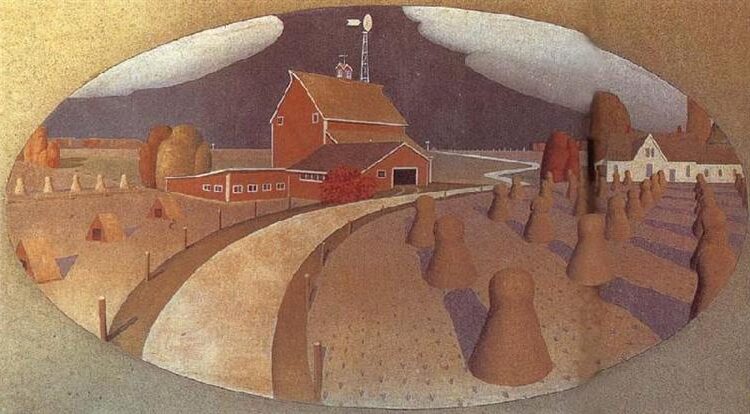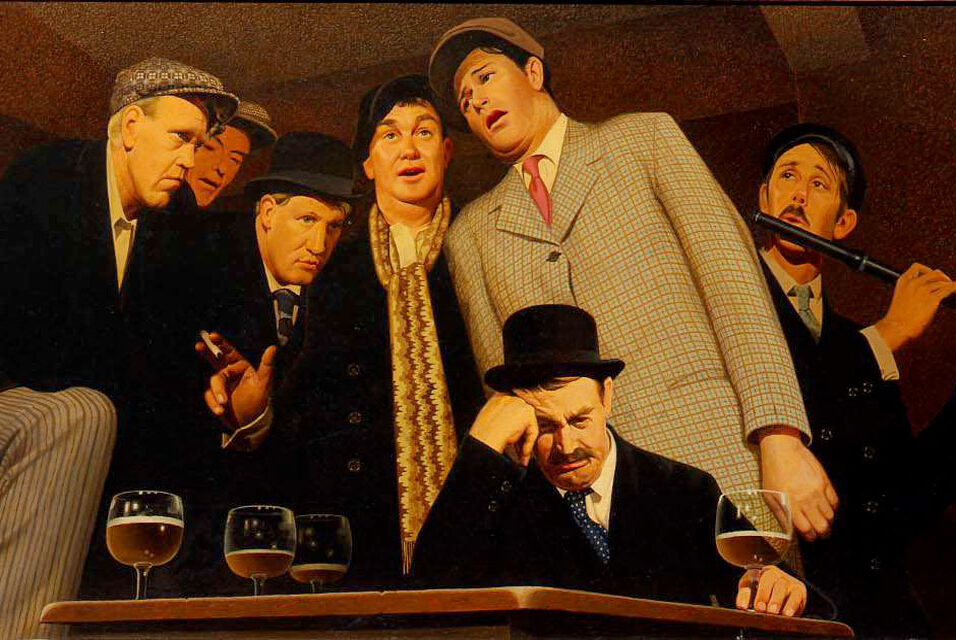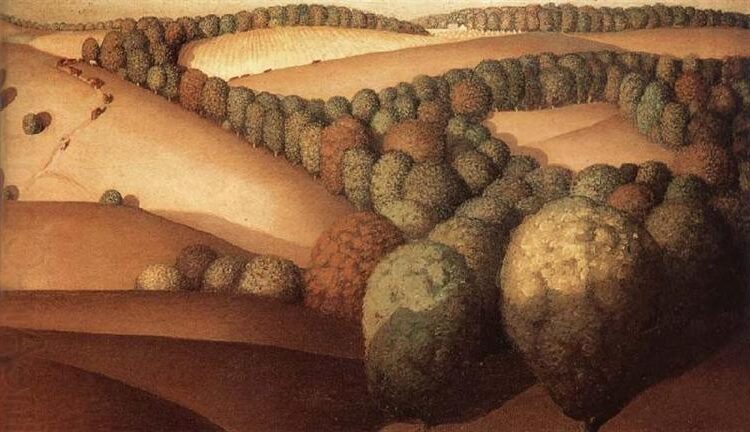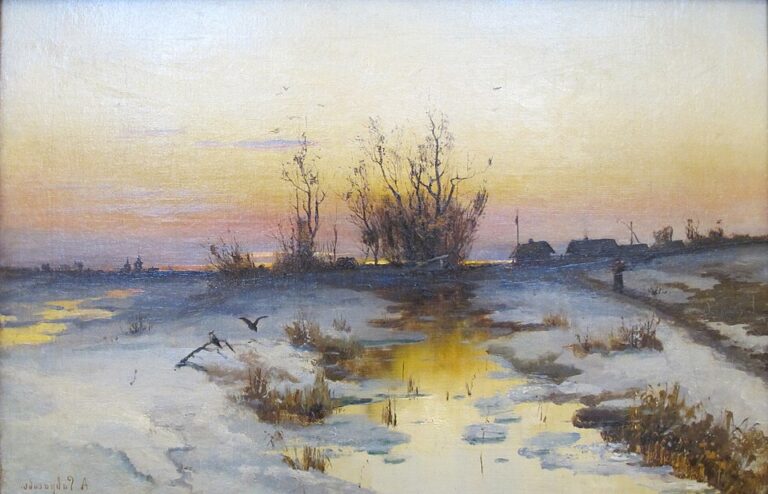Grant Wood Painter: The Iconic Maestro of American Regionalism
Born: February 13, 1891, Iowa, United States
Death: February 12, 1942, Iowa, United States
Art Movement: Regionalism
Nationality: American
Influenced By: Jan van Eyck
Institution: Académie Julian, Paris, France, School of the Art Institute of Chicago (SAIC), Chicago, IL, US
Grant Wood Painter: The Iconic Maestro of American Regionalism
Early Life and Education
Grant Wood grew up in rural Iowa, and his diverse art education shaped his distinctive artistic style. His journey from small-town America to European art centers provided a foundation for the regionalist works he would later create.
Childhood in Anamosa and Cedar Rapids
Grant DeVolson Wood was born on February 13, 1891, on a farm near Anamosa, Iowa. His early years were spent in this rural setting, which would later influence his artistic vision and subject matter.

Adoration of the Home, c.1921–1922 by Grant Wood
In 1901, Wood’s family relocated to Cedar Rapids, Iowa. This move from farm to city marked a significant transition in his life. Cedar Rapids became Wood’s primary home, where he developed his initial interest in art.
As a young student, Wood showed artistic promise. He graduated from Washington High School in Cedar Rapids in 1910, having already begun to develop his skills as a craftsman and painter.
Art Studies from Iowa to Paris
After high school, Wood expanded his artistic education at the Minneapolis School of Design and Handicraft. This formal training helped develop his technical skills and craftsmanship.
Wood’s art education wasn’t limited to the American Midwest. In 1923, he traveled to Paris to study at the prestigious Académie Julian. This year-long European experience exposed him to new artistic movements and techniques.
Upon returning to Iowa, Wood continued to refine his artistic voice. He combined European influences with American subjects, particularly those from the rural Midwest he knew intimately.
Wood’s education was both formal and self-directed. He worked as a designer and craftsman while developing his painting style, showing how his practical skills informed his fine art approach.
Artistic Career and Style

Farm View, 1932 by Grant Wood
Grant Wood’s artistic journey transformed him from a European-influenced painter to a pioneer of American Regionalism. His distinctive style celebrated Midwestern rural life through a technical approach that combined meticulous detail with stylized forms.
Development of Regionalism
Wood became a leading figure in the Regionalist movement that flourished in the 1930s during the Great Depression. After studying in Europe, he returned to Iowa with a renewed commitment to depicting American rural scenes.
Wood believed American artists should focus on subjects they knew intimately rather than imitating European traditions. His Regionalist approach celebrated the everyday life and landscapes of the Midwest, particularly Iowa’s rolling farmlands and the people who inhabited them.
This artistic philosophy emerged as a response to urbanization and economic hardship. Wood’s paintings captured an idealized vision of rural America, presenting stability and traditional values during uncertain times.
Influences and Artistic Evolution
Wood’s early work showed influences of Impressionism from his studies in Paris. A transformative trip to Germany in the late 1920s exposed him to Northern Renaissance painters, whose precision and attention to detail profoundly shaped his mature style.

Sentimental Ballad, 1940 by Grant Wood
He adopted elements from 15th-century Flemish masters, applying their technical precision to American subjects. This marriage of European technique with American content created his unique visual language.
Wood’s style evolved toward increasing stylization. He simplified forms, emphasized patterns, and created carefully structured compositions. His landscapes featured distinctive rounded hills and orderly farms that became his visual signature.
Despite his rural focus, Wood was not merely documenting farm life. He infused his works with subtle humor and occasionally satirical undertones.
Notable Works and Exhibitions
American Gothic (1930) remains Wood’s most recognized painting. Acquired by the Art Institute of Chicago shortly after completion, this portrait of a stern farmer and his daughter became an iconic image in American culture.


Other significant works include:
- Stone City, Iowa (1930) – depicting his hometown landscape
- Midnight Ride of Paul Revere (1931) – portraying American history with a toy-like quality
- Daughters of Revolution (1932) – subtly satirizing patriotic societies
Wood also created murals for public buildings as part of government art programs during the Depression. His lithograph series allowed his work to reach wider audiences at affordable prices.
Major exhibitions of Wood’s works have been held at the Whitney Museum, National Gallery of Art, and numerous regional museums. His paintings continue to tour in exhibitions exploring American identity and rural life.
Legacy and Impact
Grant Wood’s influence extends far beyond his lifetime, shaping how Americans view their cultural identity through art. His distinctive style continues to resonate with audiences and artists alike, establishing him as one of the most recognizable American painters of the 20th century.
Influence on American Identity and Art
Wood’s paintings, particularly “American Gothic,” became powerful symbols of American values and rural life during the Great Depression. His work helped define Regionalism, an art movement that celebrated the American heartland and rejected European modernist influences.

Spring Turning, 1936 by Grant Wood
Wood’s artistic approach shared similarities with Thomas Hart Benton, another prominent Regionalist who depicted American life with bold, stylized forms. His technical precision showed influences from Northern Renaissance art, which he studied during his European travels.
Wood’s paintings like “Death on the Ridge Road” captured the tension between traditional rural life and modernization. This theme of changing American identity remains relevant in contemporary discussions about national character.
Many current artists still draw inspiration from Wood’s meticulous technique and his ability to transform ordinary rural scenes into powerful statements about Americana and shared humanity.
Preservation and Display of Works
The Art Institute of Chicago houses “American Gothic,” which has become one of America’s most recognized paintings. The institute carefully preserves this iconic work, allowing visitors to view it year-round except on certain holidays.

Near Sundown, 1933 by Grant Wood
The Grant Wood Art Colony at the University of Iowa honors Wood’s legacy by supporting fellowships in painting, drawing, printmaking, and interdisciplinary performance. This program nurtures new creative talent in the spirit of Wood’s dedication to artistic development.
Wood’s murals can be found in several public buildings, preserving his larger artistic vision. His painting “Spring in the Country” demonstrates his versatility beyond the stern imagery of “American Gothic.”
Museums throughout the Midwest prioritize the preservation of Wood’s works, recognizing their significance to American cultural heritage. Special exhibitions regularly feature his paintings alongside other Regionalist artists, highlighting their collective impact on American art history.
Frequently Asked Questions
Grant Wood’s art continues to fascinate viewers with its distinctive style and cultural significance. These frequently asked questions explore the depth of his artistic contributions and lasting impact on American art.
What is the significance of Grant Wood’s ‘American Gothic’ painting?
‘American Gothic’ became one of America’s most iconic paintings after its creation in 1930. The image of a farmer holding a pitchfork standing beside a woman in front of a Gothic-style house captured the essence of Midwestern values during a challenging economic period.
The painting’s ambiguous expression leaves viewers questioning whether Wood was celebrating or satirizing rural American life. This deliberate ambiguity has contributed to its enduring appeal and recognition in American culture.
What style is Grant Wood known for?
Wood developed a distinctive style characterized by precise, stylized figures and detailed landscapes. His approach combined elements of Regionalism with influences from European art movements he encountered during his travels.
His work features meticulous attention to detail, simplified forms, and a somewhat flattened perspective. Wood’s style emphasizes clean lines and careful composition while portraying rural American subjects with subtle humor and dignified simplicity.
Can you describe the influence of Iowa on Grant Wood’s artwork?
Iowa’s rolling landscapes and farm communities provided constant inspiration for Wood’s most celebrated works. His rural upbringing in Iowa shaped his artistic vision and became central to his identity as an artist.
The state’s cornfields, small towns, and hardworking people became recurring motifs in his paintings. Wood found universal meaning in these local subjects, transforming ordinary Midwestern scenes into images with broader cultural significance.
What was Grant Wood’s contribution to American art history?
Wood helped establish Regionalism as a significant American art movement during the 1930s. This movement focused on realistic depictions of rural American scenes during the Great Depression era.
He elevated rural subjects to fine art status at a time when American artists were seeking to define a distinctly American artistic identity. Wood’s work challenged the dominance of European modernism by demonstrating that American rural life could be artistically significant.
How has Grant Wood’s legacy been preserved and celebrated?
The Grant Wood Art Colony preserves his artistic legacy through education and creative programs. His studio in Cedar Rapids, Iowa has been preserved as a historic site where visitors can experience his working environment.
Wood’s birthplace near Anamosa, Iowa, has been maintained as a tribute to his roots. His works are regularly featured in major museum exhibitions focusing on American Regionalism and 20th-century American art.
What are some notable exhibitions or collections that feature Grant Wood’s paintings?
The Art Institute of Chicago permanently houses “American Gothic,” the painting that made Wood famous. Visitors travel from around the world to see this iconic American artwork in person.
The Cedar Rapids Museum of Art in Iowa holds the world’s largest collection of Grant Wood’s works. The Whitney Museum of American Art and the Metropolitan Museum of Art in New York also display significant pieces from Wood’s portfolio in their American art collections.








